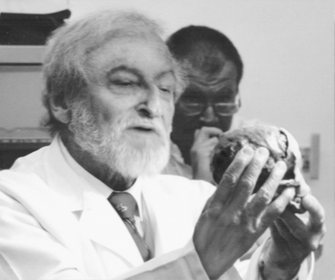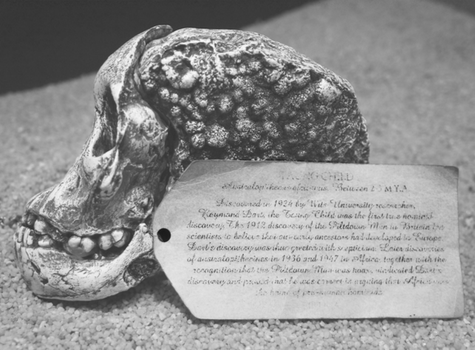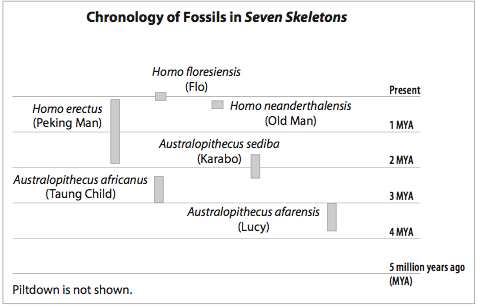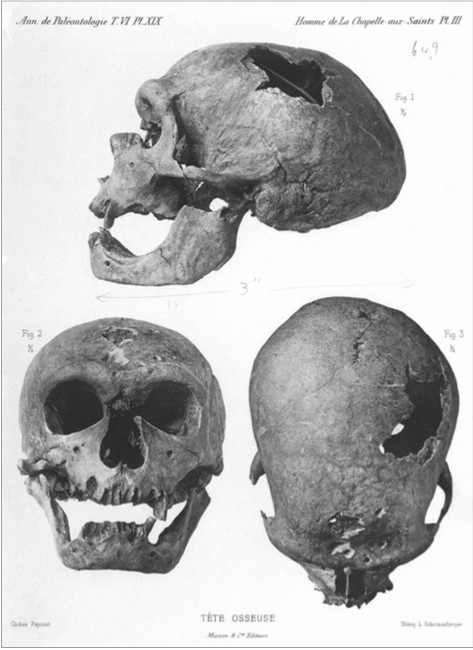
How Does a Skeleton Become Famous?
On Meeting the Taung Child and Other Celebrity Fossils
The first time I ever met a celebrity was on a June winter morning in Johannesburg.
I was an undergraduate, a student at a paleoanthropology field school in northern South Africa. As part of the summer’s human paleontology curriculum, we attended a lecture at the University of the Witwatersrand given by the school’s eminent scientist, Professor Philip Tobias. For his talk, Professor Tobias had pulled out several well-known fossil specimens from the university’s fossil vault, setting them on flat wooden trays atop red velvet, showing them off like rare gems awaiting our appraisal as we filed into the room to take our seats. As students, we all had seen casts of these fossils before, but these were the real thing.
Professor Tobias was a thin, petit man with carefully combed white hair and a meticulously knotted tie. (At a modest five foot four, I felt as if I towered over him.) He arrived for the lecture in a starched white laboratory coat clutching a small wooden box that he put at one end of the lab bench. He began his lecture by describing several of South Africa’s well-known fossil hominins, or human ancestors—picking up one of the hominin specimens in front of him, turning it over in his hands, pointing out an anatomical feature on the bone, and then carefully putting each fossil back on its tray. The man exuded gravitas and scientific solemnity. The fossils we were looking at represented decades of research and epitomized the crucial role that South Africa plays in understanding human evolution. As the stories about the different fossils seamlessly flowed together, it was obvious that Professor Tobias had given this lecture many times before, but we had never heard it. We were entranced.
But the specimen everyone was particularly keen to see was the Taung Child—a fossil whose history has loomed rather larger than life in the science of paleoanthropology. Ever since its discovery in 1924, the story of Taung Child has been chock-full of heroes, villains, theories, petty feuds, and the search for “scientific truth:” Historical tradition champions the perseverance of the fossil’s discoverer, Dr. Raymond Dart, in his belief that the fossil was, in fact, a human ancestor and not some aberrant type of fossil ape—an argument that ran against the grain of the scientific establishment in the early 20th century. When Dart’s beliefs were eventually accepted by the scientific community, the story of his dogged belief in his fossil practically became catechism in paleoanthropology: that good science will be ultimately vindicated in the face of skepticism.
Back at the fossil demo, Professor Tobias eventually worked his way down to the old wooden box at the end of the table and, with a twinkle in his eye, pulled it closer. Drawing out the anticipation, he finally opened the box with theatrical flair. Reverently, he pulled out a tiny cranium and jaw. The pieces were small, gracile, and easily fit into Tobias’s weathered hands; he told us that the wooden box was the same one that Raymond Dart himself had used to store the fossil at the University of the Witwatersrand for decades. After recounting the story of how Dart, who’d been Tobias’s own academic adviser, found the fossil in a box of breccia from the Buxton Limeworks mine, Tobias put the fossil pieces together so that the lower jaw rested under the Taung Child’s tiny face.
The fossil stared out at us, sizing up our group. Professor Tobias moved the little mandible up and down, clicking the fossil’s tiny front teeth together, and launched into a well-rehearsed comedy act of sorts that had the Taung Child telling a few jokes, commenting on the weather, and offering some insights about the early days of paleoanthropology with his good pal Raymond Dart. This ventriloquy was met with stunned, shocked silence.
The veneration that had surrounded the fossil only moments before when Tobias described its historical significance now seemed oddly out of place. To us earnest undergraduates, it was like vaudeville. How could someone as respected as Professor Tobias show off something as famous as the Taung fossil that way?!? This wasn’t the way we were supposed to experience it! The fossil should be in a vault. Or a museum display. Behind glass. Anywhere but auditioning as the straight guy for a Laurel and Hardy act.
 Professor Philip Tobias holding the Taung Child. Fossil lecture, University of the Witwatersrand. (L. Pyne)
Professor Philip Tobias holding the Taung Child. Fossil lecture, University of the Witwatersrand. (L. Pyne)
Over the last century, the search for human ancestors has spanned four continents and resulted in the discovery of hundreds of fossils. While most of these hominin finds live quietly in museum collections for experts to study, there are a few fossil ancestors, like the Taung Child, and others, like Lucy, that have become world-renowned personae, celebrities in their own right. These fossils live lives apart from their museum shelf and catalog number—because they are ambassadors of science that speak to nonexpert audiences, they have been given enough cultural cachet to transcend their status as scientific discoveries. Although the methods of scientific inquiry have changed significantly in the last hundred or so years of paleoanthropological research—to say nothing about the fluctuations in research questions and scientific paradigms—these celebrity fossils still remain part of a cultural gestalt. The fame and importance of these fossil ancestors mean that they are more than just the sum of their science; they play an important role in how audiences interact with scientific discoveries.
But what makes one discovery a celebrity and not another? Why does one fossil hominin come to have a nickname, museum exhibits, or even a Twitter handle while others simply sit in a museum drawer? And why might the answers to those questions depend heavily on the fossil’s own cultural narrative? “Skulls or remains can tell only part of a story. Bones are mute,” anthropologist Kopano Ratele suggests. “Stories must be told about them. They must be talked about, lectured on, explained, worshipped, searched for, retrieved, commemorated, archived, drawn, photographed and represented to restore their meaning. Knowledge must be built around them.”
In order to understand a fossil’s celebrity, it’s important to understand what the fossil is, where it comes from, and what kind of context it lives in. In other words, we need to situate the fossil within its own cultural history; giving it a biography built out of museums, archives, media, people the countless interactions throughout the fossil’s life after its discovery.
 Cast of the Taung Child fossil displayed in hands-on exhibit at the Origins
Cast of the Taung Child fossil displayed in hands-on exhibit at the OriginsCentre, University of the Witwatersrand, 2013. (L. Pyne)
Every fossil story is about life and death. Fossils form when plants and animals die and their remains—bones, in the case of animals—are preserved in their surrounding geologic circumstances, a process that takes thousands, sometimes millions, of years. Not all settings preserve fossils equally well. Some geological settings and landscapes are much better than others for preservation, and these areas are prized by scientists because excavations have better chances of yielding fossil discoveries. Not only are certain types of rock better than others for fossil preservation—limestone, for example, is a sedimentary rock that preserves specimens particularly well—certain landscape settings are more conducive than others for protecting the context of fossils after the organism dies. The successful interpretation of fossils hinges on understanding the kind of rock and landscape that surrounds them—being able to find fossils and then being able to appropriately contextualize them. Fossil hominins—those extinct species, ancestral taxa, with a close evolutionary relationship to modern Homo sapiens—can be particularly tricky to find and even complicated to make sense of.
The business of finding fossils—particularly fossil hominins—has a long and complicated history. Some fossils are found through almost haphazard circumstances and others through meticulous excavations. The very first fossil hominin specimens were discovered in the 19th century; although few of these early discoveries were recovered through methodical excavations. The hunt for human ancestors really began during the early 20th century when the scientific community’s hominin discoveries were popularized through newspapers, museum exhibits, and the occasional parody. Even today, the discovery of hominin fossils isn’t a given thing, and the nature of fossil discoveries is highly variable. Many fossils are found by field survey or happenstance, where other discoveries are the result of decades of systematic research at one particular site in one particular region, concentrating on fossil locales that fit a researcher’s specific agenda. Moreover, scientists can work at a site or in a particular area for a long time before anything is discovered, even when working at sites that have produced fossils in the past.
 Illustration of fossil hominin chronology, with time scale on right side. The longer the box, the longer the fossil species appears in the geological record; each of the famous fossils is listed with its corresponding species. Since Piltdown is not a real fossil, its species does not have a correlating geological time span. (L Pyne)
Illustration of fossil hominin chronology, with time scale on right side. The longer the box, the longer the fossil species appears in the geological record; each of the famous fossils is listed with its corresponding species. Since Piltdown is not a real fossil, its species does not have a correlating geological time span. (L Pyne)
But the discovery of a fossil hominin is only the first step in understanding a fossil’s evolutionary significance. From its field discovery, the fossil will generally go to a laboratory or museum associated with the research project for cleaning and there it will be assigned a catalog number, making the fossil part of a museum collection. Scientists will study the fossil and compare it with other similar finds. Measurements and photographs can be taken and analyses conducted. Although some of the technologies for comparing fossils have changed since the early 20th century (we’ve traded stereoscope slides for CT scans), comparison is still the foundation for characterizing new fossil discoveries. From Neanderthal remains discovered in the late 19th century to the latest fossil Denisovans recovered in the 21st, all fossils must be described and put into their respective contexts. At this stage, context means a description of the fossil’s geology—the type of sediment and rock that surrounded the fossil—as well as any archaeological artifacts, like stone tools, beads, or pigments, associated with the bones.
These initial studies are reported in scientific journals, and from there the life of a fossil can take a plethora of different paths. Some will simply go back to drawers and shelves in a museum laboratory; these specimens will continue to be studied and offer valuable insights into future scientific studies, but will only be described as part of a table of data—never as something singular or unique. Other fossils will have casts created for museums and laboratories so that it is easier for other scientists to see the specimen without having to ship the original to different locations. Some fossils will be brought into the media spotlight. For some particularly exciting finds, discoverers might hold press conferences to introduce their fossils to the public. Reconstructions of what the hominin might have looked like might head to museum exhibits. Scientific studies will continue. But the afterlife of these fossils isn’t predetermined and depends on a number of factors. This is where some fossil discoveries will go on to become cultural touchstones, illuminating important moments in the history of paleoanthropology, and for other fossils, that celebrity will never happen.
Thinking back on my undergraduate encounter with the Taung Child, I would venture to guess there are many, many students, scientists, researchers, and visitors who saw Dr. Tobias show off the Taung fossil with his same comedic shtick. While Dr. Tobias was alive, watching him pull the Taung Child out of its box and clack its teeth together was—and telling the story of this performance still is!—just as much a part of the fossil’s life as reading about its discovery and scientific controversy. This particular experience is just as integral to the Taung Child’s identity and history as its scientific papers and museum publications.
It is easy to think that a fossil’s importance comes strictly from its scientific value. Scientific significance is certainly a reason for fame, but it is not the only reason. Some fossils are famous for being “the first,””the most,” or “the earliest” of something. Some are famous for the mystery and intrigue that surround them. Some are icons. Some are fake. Some are forgotten. Some fossils are famous, to echo cultural critic Daniel Boorstin, simply for being famous. All famous fossils, however, are fundamentally shaped by their various audiences, and as the audiences and contexts change, so does the nature of the fossils’ celebrity. All celebrity fossils have a flashpoint where science, culture, and history intersect to ignite their fame. The fortunes of these famous fossils live and die within their cultural provenience-within their contexts and their histories.
This is particularly true in how we personify fossils, especially fossil hominins. To be a successful celebrity, the specimen moves from “only” being a famous object (an “it”) and moves into becoming a “him” or a “her.” It gets a moniker—a nickname—and a persona that become the cultural shorthand for the historical, physical, and psychological factors within it. Through the simple bestowing of a name and a pronoun, we are in effect granting the fossil agency, likability, and even a moral dimension. “Celebrity is made by simple familiarity, induced and re-enforced by public means,” argues Boorstin.”The celebrity therefore is the perfect embodiment of tautology; the most familiar is the most familiar.” We judge the fossil by the stories we tell about it, and famous fossils are stories of heroism, notoriety, and celebrity. Since fossils lack any sort of intrinsic agency, their significance comes from the people and cultures that surround them. We shape their stories of fame today, just as historical forces shaped their interpretations in the past. When we understand the stories of these fossils, we see how science, history, and popular culture interact to produce celebrity scientific discoveries—that intersection means that these fossil human ancestors become cultural yardsticks through a huge number of material texts.
These bits and pieces of material life surround each of the seven famous hominin fossils in this book. These are fossils with postcards, formal portraits, curated exhibits, T-shirts, and posters. (Gentle reader, I have even seen a set of nail clippers in a visitors’ center gift shop with the likeness of Mrs. Ples, well-known fossil from South Africa, enameled on the top.) The ephemera that surrounds a celebrity fossil is a part of its social archive and part of its own cultural identity.
But this circles back to the question of why certain fossils become famous. Which ones can and do achieve status as superstars? And what kind of celebrity cultural history would set one fossil apart from others? “How could you write a book about famous fossils and not write about Mrs. Ples?!?” a horrified colleague asked me when I outlined this book idea to her, listing the fossils I planned to write about. “Or Ardi? What about Java Man, from 1891? Or, wow, any of the fossils that the Leakey family has found in decades of working in East Africa?!? How could you not include those???” She was polite enough not to follow her line of questioning with, “What kind of book is this?!?”
The question is certainly a fair one. What makes these seven fossils that I profile here famous in ways that differ from the many, many other specimens that fill laboratories, collections, and museums? These other fossils carry scientific significance and cultural import … why haven’t they reached the celebrity echelons that these seven enjoy?
I’ve chosen to write the biographies of seven fossils that I feel tell us how scientific discoveries become written into popular culture and scientific ethos. These fossils are born through fantastical stories of discovery and live their lives, successfully resonating with audiences over decades. “[Museum specimens’] fame in life and their iconic status in death defy taxonomy,” notes museum historian Samuel Alberti. “They are not only specimens, but also personalities; not only data, but also historical documents.” In other words, the stories and traditions associated with these fossils—their cultural identities—can’t be separated from the story of who interprets them and how they acquire meaning.
These types of famous fossils are given pithy nicknames, written into evolutionary story lines, aggressively marketed, and, arguably, easily become cultural touchstones. As these fossils pop up in every day media, as they live in museum exhibits, and as they continue to provoke deep scientific questions, their bones make cultural demands. Kopano Ratele suggests: “To become part of a culture, discipline, or project, bones need interpreters—paleontologists, painters, sculptors, kin.” These famous fossils help us understand how we make sense of our fossil ancestry.
Not only are these seven fossils all celebrated discoveries, each fossil illustrates a different kind of fame or notoriety within scientific and public circles. Lucy has become an icon; the Taung Child a folk hero. The Old Man of La Chapelle established the cultural archetype for Neanderthals. The Piltdown Hoax became a cautionary tale about preconceptions in science. The Peking Man fossils from Zhoukoudian took on a dramatic flair of paleo-noir as the fossils were lost and have never been recovered, vanished into legend like the Maltese Falcon. Flo is inexorably linked with her hobbit-infused identity. And the most recent fossil celebrity; Sediba, has embarked on a public relations campaign to become a fossil of serious scientific repute since its publication in 2010. These fossils are vivid examples of how discoveries have been received, remembered, and immortalized and serve as reminders of how our past as a species continues to impact, in astounding ways, our present culture and imagination.
 Map of the seven fossil discoveries. (S. Seibert)
Map of the seven fossil discoveries. (S. Seibert)
These fossils live rich, vibrant lives, even though they are nominally tucked into their vaults at various museums. These seven tell us about our evolutionary ancestry—they give us millions of years worth of details about adaptations, selection pressures, even paleoenvironments—that preceded Homo sapiens. They demonstrate that science is a social and cultural process—how hypotheses are evaluated, how theories change, how technology is an ever changing tool for creating knowledge. As the stories of these fossils are told and retold, adding layer upon layer of cultural meaning, their histories become ever more entwined with our own.
 The Old Man of La Chapelle. These pen-and-ink drawings of the Neanderthal were created by Monsieur J. Papoint, under the direction of Marcellin Boule, and printed in Boule’s L’Homme Fossile de La Chapelle-aux-Saints, 1911.
The Old Man of La Chapelle. These pen-and-ink drawings of the Neanderthal were created by Monsieur J. Papoint, under the direction of Marcellin Boule, and printed in Boule’s L’Homme Fossile de La Chapelle-aux-Saints, 1911.
From SEVEN SKELETONS: The Evolution of the World’s Most Famous Human Fossils by Lydia Pyne, published by Viking, an imprint of Penguin Publishing Group, a division of Penguin Random House LLC. Copyright © 2016 by Lydia V. Pyne.
Lydia Pyne
Lydia Pyne is a writer and historian, interested in the history of science and material culture. She has degrees in history and anthropology and a PhD in history and philosophy of science from Arizona State University, and is currently a visiting researcher at the Institute for Historical Studies at the University of Texas at Austin. Her field and archival work has ranged from South Africa, Ethiopia, Uzbekistan, and Iran, as well as the American Southwest. Lydia's writing has appeared in The Atlantic, History Today, Time, The Scientist, Nautilus, The Appendix, Lady Science and Electric Literature as well as The Public Domain Review, and her previous book was Seven Skeletons, the story of human origins. She lives in Austin, Texas, where she is an avid rock climber and mountain biker.



















